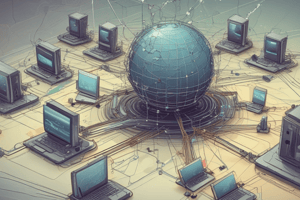Podcast
Questions and Answers
What is a computer network?
What is a computer network?
A computer network is a group of computers and peripheral devices linked together to share data and hardware resources.
List two advantages of networking in organizations.
List two advantages of networking in organizations.
Resource sharing and reduction in cost are two advantages of networking in organizations.
What is meant by 'resource sharing' in a computer network?
What is meant by 'resource sharing' in a computer network?
Resource sharing refers to the ability of all users in a network to access shared hardware and software resources like printers and files.
How does networking reduce costs for organizations?
How does networking reduce costs for organizations?
Give an example of a type of network observed in daily life.
Give an example of a type of network observed in daily life.
What transformation does a computer network bring to the world?
What transformation does a computer network bring to the world?
What role does a central computer play in resource sharing?
What role does a central computer play in resource sharing?
What are some common devices that can be shared in a computer network?
What are some common devices that can be shared in a computer network?
What is one way that networking can increase storage capacity for users?
What is one way that networking can increase storage capacity for users?
How does networking facilitate faster data transfer between computers?
How does networking facilitate faster data transfer between computers?
What advantage does a server provide for backing up data in a network?
What advantage does a server provide for backing up data in a network?
Identify a method by which networking reduces data inconsistency.
Identify a method by which networking reduces data inconsistency.
What is data redundancy and how does networking help to reduce it?
What is data redundancy and how does networking help to reduce it?
What security measures are typically implemented in a computer network?
What security measures are typically implemented in a computer network?
What is a possible disadvantage related to the management of a large computer network?
What is a possible disadvantage related to the management of a large computer network?
What could happen if a server in a network experiences a breakdown?
What could happen if a server in a network experiences a breakdown?
What is the function of a network card in a computer network?
What is the function of a network card in a computer network?
Describe the structure and function of modern Ethernet networking cables.
Describe the structure and function of modern Ethernet networking cables.
What role does a modem play in a networking setup?
What role does a modem play in a networking setup?
Differentiate between a hub and a switch in networking.
Differentiate between a hub and a switch in networking.
What does a router do in a network system?
What does a router do in a network system?
Explain the broadcasting process that occurs in a hub.
Explain the broadcasting process that occurs in a hub.
How does the operation of a switch enhance network speed?
How does the operation of a switch enhance network speed?
What type of connection does a modem establish for internet access?
What type of connection does a modem establish for internet access?
What is the primary function of wireless network cards?
What is the primary function of wireless network cards?
How do access points or routers enhance wireless networking?
How do access points or routers enhance wireless networking?
Define a Personal Area Network (PAN) and its typical range.
Define a Personal Area Network (PAN) and its typical range.
What distinguishes a Local Area Network (LAN) from a Personal Area Network (PAN)?
What distinguishes a Local Area Network (LAN) from a Personal Area Network (PAN)?
What is a Metropolitan Area Network (MAN) and where is it typically used?
What is a Metropolitan Area Network (MAN) and where is it typically used?
Describe the main characteristic of a Wide Area Network (WAN).
Describe the main characteristic of a Wide Area Network (WAN).
What types of devices typically connect in a Personal Area Network (PAN)?
What types of devices typically connect in a Personal Area Network (PAN)?
What is one advantage of using a Local Area Network (LAN)?
What is one advantage of using a Local Area Network (LAN)?
What is a major advantage of the network topology described?
What is a major advantage of the network topology described?
What is a significant challenge of the network topology mentioned?
What is a significant challenge of the network topology mentioned?
List the initial step to access a file from a shared drive.
List the initial step to access a file from a shared drive.
What is meant by network security?
What is meant by network security?
What role does 'Login Security' play in network security?
What role does 'Login Security' play in network security?
Why is it important to limit data access to authorized personnel?
Why is it important to limit data access to authorized personnel?
What actions can former employees potentially take regarding company data?
What actions can former employees potentially take regarding company data?
Define computer networking in a concise manner.
Define computer networking in a concise manner.
What is networking, and provide two advantages of networking?
What is networking, and provide two advantages of networking?
Differentiate between LAN and WAN.
Differentiate between LAN and WAN.
What are two advantages of Star topology?
What are two advantages of Star topology?
Explain Client-Server architecture in your own words.
Explain Client-Server architecture in your own words.
Differentiate between a hub and a switch.
Differentiate between a hub and a switch.
Flashcards
Computer Network
Computer Network
A collection of computers and devices connected to share resources and data.
Resource Sharing
Resource Sharing
The ability for multiple users on a network to access hardware like printers or scanners connected to a central computer.
Cost Reduction in Networks
Cost Reduction in Networks
The cost of hardware is reduced because multiple users share the same equipment.
Communication Network
Communication Network
Signup and view all the flashcards
Local Area Network (LAN)
Local Area Network (LAN)
Signup and view all the flashcards
Wide Area Network (WAN)
Wide Area Network (WAN)
Signup and view all the flashcards
Network Topology
Network Topology
Signup and view all the flashcards
Network Security
Network Security
Signup and view all the flashcards
Increased Storage Capacity
Increased Storage Capacity
Signup and view all the flashcards
Fast Data Transfer
Fast Data Transfer
Signup and view all the flashcards
Easy to Take Backup
Easy to Take Backup
Signup and view all the flashcards
Reduces Data Inconsistency
Reduces Data Inconsistency
Signup and view all the flashcards
Reduced Redundancy
Reduced Redundancy
Signup and view all the flashcards
Increases Security
Increases Security
Signup and view all the flashcards
Additional Cost of Networking Equipment
Additional Cost of Networking Equipment
Signup and view all the flashcards
Management of Large Network
Management of Large Network
Signup and view all the flashcards
Network card
Network card
Signup and view all the flashcards
Ethernet cable
Ethernet cable
Signup and view all the flashcards
Modem
Modem
Signup and view all the flashcards
Hub
Hub
Signup and view all the flashcards
Switch
Switch
Signup and view all the flashcards
Router
Router
Signup and view all the flashcards
LAN (Local Area Network)
LAN (Local Area Network)
Signup and view all the flashcards
WAN (Wide Area Network)
WAN (Wide Area Network)
Signup and view all the flashcards
Wireless Network Card
Wireless Network Card
Signup and view all the flashcards
Access Point or Router
Access Point or Router
Signup and view all the flashcards
Personal Area Network (PAN)
Personal Area Network (PAN)
Signup and view all the flashcards
Metropolitan Area Network (MAN)
Metropolitan Area Network (MAN)
Signup and view all the flashcards
Combination Wired and Wireless Network
Combination Wired and Wireless Network
Signup and view all the flashcards
Radio Signals (Wireless Communication)
Radio Signals (Wireless Communication)
Signup and view all the flashcards
Star Topology
Star Topology
Signup and view all the flashcards
Ring Topology
Ring Topology
Signup and view all the flashcards
Bus Topology
Bus Topology
Signup and view all the flashcards
Hybrid Topology
Hybrid Topology
Signup and view all the flashcards
Login Security
Login Security
Signup and view all the flashcards
Rights Security
Rights Security
Signup and view all the flashcards
What is a network?
What is a network?
Signup and view all the flashcards
What is a LAN?
What is a LAN?
Signup and view all the flashcards
What is a hub?
What is a hub?
Signup and view all the flashcards
What is a switch?
What is a switch?
Signup and view all the flashcards
Study Notes
Networking Concepts
- A computer network is a group of computers and other devices connected to share data and resources
- Networking improves efficiency, economy, and effectiveness in organizations
- Networking components include computers, peripherals, network cards, cables, modems, hubs, switches, routers, and network software
- Networks are classified by their size and geographic scope, including:
- PAN (Personal Area Network): For personal use, covering small areas like homes or offices
- LAN (Local Area Network): Connects devices in limited areas like homes, offices, or schools
- MAN (Metropolitan Area Network): Covers areas like cities and usually combines smaller networks
- WAN (Wide Area Network): Connects larger areas, like countries or continents, often using telephone lines or satellite connections. A common example is the internet
- Network Architecture: An overall design that defines how a network is structured and functions.
- Client-Server: A central server provides resources, and client devices request services (e.g., data retrieval)
- Peer-to-Peer: Computers share resources equally; no central server (e.g., file sharing)
- Network Topologies: Physical layout of the network connections
- Point-to-Point: Direct connection between two devices, common in small networks
- Bus: All devices are connected to a single cable (backbone).
- Star: Devices connect to a central hub/switch. A failure in one device doesn't affect the entire network
- Ring: Devices connected in a circle; data travels in one direction
- Tree: Star topologies connected to a backbone cable (a more complex network)
- Mesh: All devices connect to every other device; redundancy and high fault tolerance
Network Advantages
- Resource Sharing: Hardware and software resources are shared across the network
- Cost Reduction: Shared hardware reduces hardware costs, and licensing costs may be reduced.
- Increased Storage Capacity: Files can be stored on remote computers, increasing available space
- Fast Data Transfer: Data transfers between computers are faster than when using local storage.
- Backup: A central server automates data backups
- Reduced Data Inconsistency: Data duplication is reduced and only updated in one central place
Network Disadvantages
- Additional Cost of Networking Equipment: Initial outlay can be significant to set up the network properly
- Management of Large Networks: Large networked systems may require significant expertise to manage and maintain
- Server Breakdown: If the main server fails, the entire network is affected
- Security Issues: Vulnerability to unauthorized access, viruses and other security threats
Network Components
- Network Card: Connects a computer to a network
- Networking Cable: Physical connection between devices
- Modem: Connects to a phone line to transmit data
- Hubs: Broadcast data to all connected devices
- Switches: Direct data to the intended device only, resulting in faster data transmission
- Routers: Direct data across different networks
Accessing Network Resources
- Network security is crucial to protect data
- Authorized access is controlled using login names and passwords
Wireless Networking
- Uses radio waves instead of physical cables
- Wireless network cards and access points are used to connect wireless devices
- Radio signals are easier to install, but have limited range
- Network cards are needed for computers
Studying That Suits You
Use AI to generate personalized quizzes and flashcards to suit your learning preferences.





